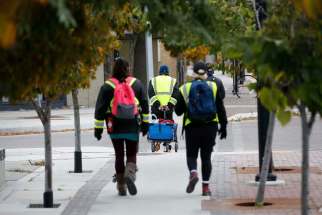Right place, right time Downtown Bay building a monument to colonization's brutality, but it could be transformed into a place of Indigenous positivity, reconciliation
Read this article for free:
or
Already have an account? Log in here »
To continue reading, please subscribe:
Monthly Digital Subscription
$19 $0 for the first 4 weeks*
- Enjoy unlimited reading on winnipegfreepress.com
- Read the E-Edition, our digital replica newspaper
- Access News Break, our award-winning app
- Play interactive puzzles
*No charge for four weeks then billed as $19 plus GST every four weeks. Offer only available to new and qualified returning subscribers. Cancel any time.
Read unlimited articles for free today:
or
Already have an account? Log in here »
Hey there, time traveller!
This article was published 04/10/2020 (1544 days ago), so information in it may no longer be current.
Three-and-a-half centuries after Hudson’s Bay Co. received its first charter — giving Prince Rupert and his “Company of Adventurers of England” an exclusive trading monopoly over the entire Hudson Bay drainage basin — its biggest symbol of colonization is coming to an end.
In February, the company plans to close its six-storey flagship store at Portage Avenue and Memorial Boulevard, literally Canada’s gateway to the West.
When it opened in 1926, its palatial architecture was an homage to proper and profitable English civilization. As a testament to the Empire, the Union Jack once flew high on its rooftop, towering over a burgeoning city, pronouncing progress and evolution.
Inside were goods manufactured from Canada’s settling of the plains: furs, blankets, and, eventually, Guess cologne (that’s what I bought there, anyways). Everything Canada, including Olympic gear, came from HBC.
At one time, the building was “a testament to the wealth being amassed in this colonized land,” as my Free Press colleague Melissa Martin wrote, but eventually became, “an impossible building. Too big, too costly, too proud.”
So, this is how colonization ends. The people who profit the most take all they can from the land and people within it, and then quietly leave when there’s nothing left to take. Soon, all that will be left is an empty, lifeless pile of plaster and metal that will cost millions to repair or remove for those who actually live here.
Really, though, this is how colonization continues. HBC is not a retail empire — never really was — but a massive real estate company. Just as King Charles II gave Prince Rupert lands that were not his to give, HBC holds deeds to billions of dollars of global property (much within former Rupertsland itself) and will march on. As proof, I will be able to buy my cologne at Bay locations at St. Vital or Polo Park.
HBC’s legacy of exploitation, violence and theft is permanent, though.
HBC began with profits from the slave trade and cheap goods from the British colonies. It was instrumental in manufacturing goods for the Commonwealth, the world’s oldest economic superpower. Alongside were billions built off Indigenous lands and resources.
Indigenous peoples benefited from the fur trade, of course, but they paid far more than profited. On its website, HBC admits it “relied on Indigenous expertise for general survival, surveying, trapping, translating, kinship and much more” to build the company, but when it came to sharing profits and the land (particularly when transferring Rupertsland to Canada in 1870), everything was done “without consulting First Nations or Métis inhabitants.”
Canada may have instituted poverty via the Indian Act and residential schools, but HBC opened the door.
As National Indian Brotherhood Chief George Manuel said at the company’s 300th anniversary: “The company was responsible for the misery, deprivation and exploitation of Canada’s Indigenous peoples.”
HBC began with profits from the slave trade and cheap goods from the British colonies. It was instrumental in manufacturing goods for the Commonwealth, the world’s oldest economic superpower. Alongside were billions built off Indigenous lands and resources.
So, yes, the HBC building means a lot to Winnipeg beyond warm memories of the Paddlewheel restaurant, although I have those too. The building is the face of British occupation, theft and the first steps of genocide.
It’s a conspicuous site. Therefore, recovering it requires an conspicuous solution.
Let’s make Winnipeg’s most non-Indigenous space Indigenous space. Let’s make it a place where our community can renew, change, and enter the next 350 years of our lives together.
There are tons of arguments for this. Indigenous peoples are Manitoba’s fastest-growing population and most live downtown. Nowhere are investments needed more for Manitoba’s future than in Indigenous young people, who will become Winnipeg’s middle class. You can already see this in Winnipeg’s art, music and political scene, but soon it will be doctors, lawyers and business owners, too.
I’m invested in seeing an Indigenous-run university such as the First Nations University of Canada in Regina, but a mixed-use commercial space might be more sustaining. Also, is everyone aware that the seven First Nations in Treaty One are still owed hundreds of acres of land and urban reserves are the most financially sound idea in western Canadian cities today?
I envision a building with students, elders and, perhaps, a new Winnipeg Friendship Centre. How about inviting the National Centre for Truth and Reconciliation downtown? The Manitoba First Nations Education Resource Centre? The Manito Ahbee Festival? The Manitoba Indigenous Music Hall of Fame?
Add in organizations that need space and support and would benefit from closer ties with the Indigenous community, such as the Hudson’s Bay Company Archives or the Women’s Health Clinic, and the space fills up fast.
We could give it a name, a spirit and new life.
We could even call it a site of reconciliation.
This February, we have an incredible opportunity to step into our future and we will have the HBC to thank. Imagine that.
niigaan.sinclair@freepress.mb.ca

Niigaan Sinclair
Columnist
Niigaan Sinclair is Anishinaabe and is a columnist at the Winnipeg Free Press.
Our newsroom depends on a growing audience of readers to power our journalism. If you are not a paid reader, please consider becoming a subscriber.
Our newsroom depends on its audience of readers to power our journalism. Thank you for your support.
History
Updated on Tuesday, October 6, 2020 4:48 PM CDT: Fixes typos







